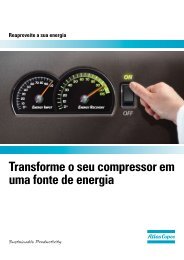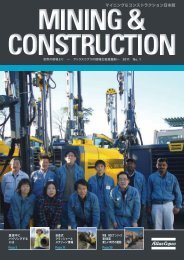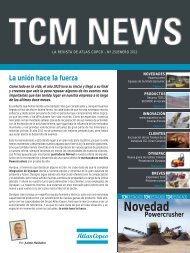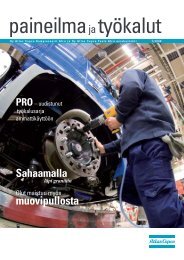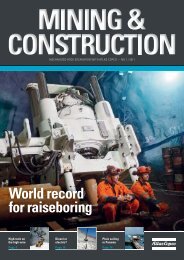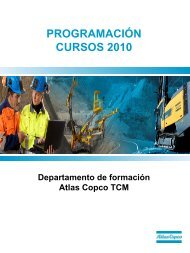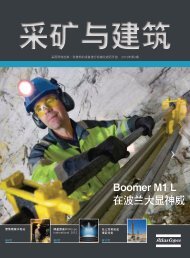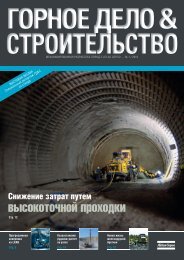Atlas Copco rd20 in the permian Basin
Atlas Copco rd20 in the permian Basin
Atlas Copco rd20 in the permian Basin
Create successful ePaper yourself
Turn your PDF publications into a flip-book with our unique Google optimized e-Paper software.
The <strong>Atlas</strong> <strong>Copco</strong> RD20 and o<strong>the</strong>r equipment with Butch’s Rathole<br />
The <strong>Atlas</strong> <strong>Copco</strong> <strong>rd20</strong> drill<strong>in</strong>g rig was<br />
first <strong>in</strong>troduced to <strong>the</strong> market <strong>in</strong> 1986.<br />
It was orig<strong>in</strong>ally designed for drill<strong>in</strong>g<br />
shallow oil and gas, as well as coal bed<br />
methane (CBM). S<strong>in</strong>ce its <strong>in</strong>troduction<br />
to <strong>the</strong> market, approximately 250 RD20s<br />
have been built and shipped all over <strong>the</strong><br />
world. The RD20, smaller and more mobile<br />
than conventional rigs, is often used<br />
to cheaply and efficiently complete <strong>the</strong><br />
pre-set work.<br />
Butch’s Rat Hole and Anchor Service<br />
is currently us<strong>in</strong>g <strong>the</strong> <strong>Atlas</strong> <strong>Copco</strong> RD-20<br />
drill<strong>in</strong>g rig to do <strong>the</strong> pre-set work ahead<br />
of conventional rigs <strong>in</strong> Odessa, Texas.<br />
This pre-set work, which is also referred<br />
to as “top-hole work” consists of drill<strong>in</strong>g<br />
and sett<strong>in</strong>g surface cas<strong>in</strong>g ahead of<br />
deeper drill<strong>in</strong>g rigs that come <strong>in</strong> to get <strong>the</strong><br />
well to total depth.<br />
Hir<strong>in</strong>g companies like Butch’s to do this<br />
type of work can save time and money,<br />
allow<strong>in</strong>g conventional rigs to move on<br />
location, nipple-up and go straight <strong>in</strong>to<br />
drill<strong>in</strong>g <strong>the</strong> <strong>in</strong>termediate and production<br />
sections.<br />
On August 25 th, Driller Bob Morris and<br />
his crew drilled six 12 ¼ <strong>in</strong>ch (31.12 centimeters)<br />
surface holes, rang<strong>in</strong>g from<br />
depths of 350 to 650 feet (106.7 to 198 meters),<br />
and set 9 5 / 8 <strong>in</strong>ch (24.45 centimeter)<br />
surface cas<strong>in</strong>g. Us<strong>in</strong>g down-<strong>the</strong>-hole hammer (DTH or DHD) drill<strong>in</strong>g<br />
methods, <strong>the</strong> crew was able to more quickly and efficiently drill through<br />
<strong>the</strong> naturally tough subsurface formations of West Texas.<br />
DTH drill<strong>in</strong>g, also known as “percussion drill<strong>in</strong>g” uses air compressors<br />
to provide a sufficient pressure and volume of air to operate <strong>the</strong><br />
hammer and clean <strong>the</strong> hole. Compressed air flows down <strong>the</strong> drill str<strong>in</strong>g<br />
said, “The QL120 hammered all <strong>the</strong> way<br />
to TD [total depth] at 380 feet (116 meters).”<br />
Monday morn<strong>in</strong>g, Butch’s held up<br />
<strong>the</strong>ir side of <strong>the</strong> deal and handed Erickson<br />
a check for <strong>the</strong> RD20.<br />
The red bed is a reddish-colored, claylike<br />
shale stratum, roughly 200 to 1,400<br />
feet (61 to 427 meters) from surface, <strong>in</strong> <strong>the</strong><br />
West Texas Permian Bas<strong>in</strong> oil field. Drillers<br />
currently use PDC or tricone bits, drill<strong>in</strong>g<br />
with mud to raise <strong>the</strong> cutt<strong>in</strong>gs. To drill<br />
us<strong>in</strong>g air on <strong>the</strong> first hole, Erickson <strong>in</strong>jected<br />
35 gpm (2.2 l/s) of water, foam and polymer<br />
to lift <strong>the</strong> cutt<strong>in</strong>gs. Once drilled, cas<strong>in</strong>g was<br />
<strong>in</strong>stalled immediately because <strong>the</strong> red bed<br />
will swell, mak<strong>in</strong>g it difficult or impossible<br />
to <strong>in</strong>stall cas<strong>in</strong>g.<br />
Smart Air power<br />
To have enough air, Butch’s purchased an<br />
auxiliary compressor to <strong>in</strong>crease air availability.<br />
They chose <strong>the</strong> new <strong>Atlas</strong> <strong>Copco</strong><br />
DrillAir XRVO 1550 CD7. This open skid<br />
deep hole driller – 2 / 2010<br />
where it provides power to <strong>the</strong> percussion<br />
hammer and cleans <strong>the</strong> hole of <strong>the</strong><br />
cutt<strong>in</strong>gs. In <strong>the</strong> right application, this<br />
drill<strong>in</strong>g technique provides a faster rate<br />
of penetration, ma<strong>in</strong>ta<strong>in</strong>s a straighter<br />
hole, and elim<strong>in</strong>ates <strong>the</strong> environmental<br />
impact of drill<strong>in</strong>g fluids.<br />
Though most drillers <strong>in</strong> <strong>the</strong> <strong>in</strong>dustry<br />
would be surprised by <strong>the</strong> aforementioned<br />
numbers, Morris’ crew attributes<br />
<strong>the</strong>ir progress to <strong>the</strong> sophisticated equipment<br />
<strong>the</strong>y’ve been us<strong>in</strong>g.<br />
The <strong>Atlas</strong> <strong>Copco</strong> 1550 skid-mounted<br />
compressor, which is <strong>the</strong> largest s<strong>in</strong>gle<br />
eng<strong>in</strong>e compressor on <strong>the</strong> market, performs<br />
1500 CFM @ 365 PSI, or 2800 CFM<br />
with two compressors. Morris describes<br />
<strong>the</strong> efficiency and reliability of <strong>the</strong> product,<br />
add<strong>in</strong>g “It’s nice to have a piece of<br />
equipment that you can turn on and walk<br />
away from.”<br />
Ano<strong>the</strong>r accessory used by Morris’<br />
crew is <strong>the</strong> Hydrocyclone hammer feature.<br />
Designed and patented by <strong>Atlas</strong><br />
<strong>Copco</strong>, <strong>the</strong> Hydrocyclone improves performance<br />
by elim<strong>in</strong>at<strong>in</strong>g <strong>in</strong>jected water<br />
before it gets to <strong>the</strong> hammer, yet still allow<strong>in</strong>g<br />
for water mist to clean <strong>the</strong> hole.<br />
The hole is cleared of excess water and<br />
<strong>the</strong>refore <strong>in</strong>creases <strong>the</strong> rate of penetration<br />
as fluids are <strong>in</strong>jected.<br />
Morris expla<strong>in</strong>ed that each hole took about an hour and a half to<br />
drill, add<strong>in</strong>g “it took longer to set <strong>the</strong> cas<strong>in</strong>g that it did to drill <strong>the</strong> hole.”<br />
Morris’ crew used threaded and coupled cas<strong>in</strong>g. Us<strong>in</strong>g T&C cas<strong>in</strong>g,<br />
<strong>the</strong> crew was able to save time and elim<strong>in</strong>ate some of <strong>the</strong> problems<br />
that may be present with welded end cas<strong>in</strong>g, such as cracked welds<br />
and misalignments.<br />
At <strong>the</strong> controls is Bob Morris with D.C. Carter at left and B.J. Crawford hold<strong>in</strong>g <strong>the</strong> rope.<br />
5



